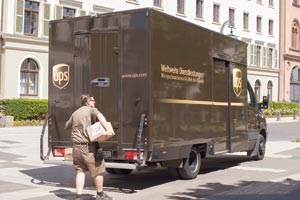UPS 3Q Earnings Increase 3.5% on Stronger Base Freight Rates

UPS Inc. posted a 3.5% increase in third-quarter net income to $1.26 billion, compared with the same three months in 2014, even as quarterly revenue dipped by 0.4% to $14.24 billion.
The Atlanta-based company, No. 1 on the Transport Topics Top 100 list of the largest U.S. and Canadian for-hire carriers, said revenue growth was hemmed in by fuel surcharges that fell year-over-year and a strong U.S. dollar that devalued the contribution of foreign operations. Volume growth was mixed, varying by type of shipping and geography, but the world’s largest trucking company said in its Oct. 27 earnings report and conference call that it often was able to improve base freight rates as fuel surcharges declined.
UPS management predicted a strong fourth quarter, which will be dominated by holiday-related consumer spending. Problems with third-quarter volume were attributed to declines in U.S. manufacturing exports as other nations struggled to buy goods made here.
Quarterly earnings per share rose to $1.39 from $1.32.
“Our international segment again produced double-digit growth in operating profits. The U.S. domestic [package] and supply chain and freight units performed as planned. We are pleased with the results this quarter, especially given the uneven global economy,” CEO David Abney said during the conference call.
The largest contributor to profit increase came from the international package division, which jumped 10.2% to $507 million for the quarter, even as the division’s revenue dropped 7% and volume dipped by 1.5%.
The work that remained paid better, though, as quarterly operating margin increased to 17.1% from 14.45% during last year’s quarter.
Fuel surcharge revenue dropped along with fuel costs, but “underlying base rates increased across all regions of the world,” the report said.
U.S. ground parcel shipping, the company’s largest single service line, saw volume dip by 0.8% year-over-year to 12.11 million packages per day. However, quarterly revenue for the division grew by 1.4% to $6.3 billion because average revenue per ground package expanded by 0.6% to $8.02.
In ground shipping, the company also was able to bolster basic freight rates as fuel-surcharge revenue retreated.
In terms of domestic volume, the company’s deferred air segment did best, adding 13.2% for the quarter and topping a small gain at next-day air and the contraction at ground.
“UPS is doing about as well as one could hope in a market management describes as uneven, including a U.S. industrial economy the company sees in contraction,” analyst David Ross said in an investor’s note to clients of Stifel, Nicolaus & Co.
At UPS Freight, the company’s less-than-truckload carrier, quarterly volume declined, but pricing improved. Quarterly LTL revenue dropped 9.5% to $631 million.
Shipments transported dropped by 5.2%, and the average weight per shipment shrank by the same 5.2%, meaning gross weight hauled during the quarter fell by 10.2% to 2.77 billion pounds from 3.1 billion in last year’s third quarter.
However, LTL revenue per hundredweight grew by 0.8% to $22.78.
“We’ve seen rate action being taken by everyone in the [LTL] industry, but specifically for UPS Freight, we’ve worked to shed some unprofitable customers all year long,” said Myron Gray, UPS president of U.S. operations.
Abney and Gray were keen to talk about the acquisition of Coyote Logistics, a deal completed in mid-August.
Abney said the $1.8 billion purchase “will enable us to better manage UPS backhaul capacity and purchased transportation spend.”
He said UPS Freight’s brokerage unit transitioned to Coyote’s order-management platform in October and should help with November-December parcel shipping.
UPS Chief Commercial Officer Alan Gershenhorn said the company will continue to lean on technology to make deliveries during the upcoming peak holiday season.
In December 2013, UPS said the volume of express packages exceeded its capacity to process them, and the company had to offer refunds to some customers whose packages did not arrive by Dec. 24.
“Between Thanksgiving and New Year’s, we expect to complete about 10% more deliveries compared to the same period last year. And then on our planned peak day, Dec. 22, we are scheduled to deliver about 36 million packages worldwide, more than twice a typical day,” Gershenhorn said.
ORION, or UPS’ On-Road Integrated Optimization and Navigation software, will be used by 70% of the company’s U.S. drivers this year, up from 45% in the 2014 season.
Gershenhorn said the change will allow UPS more flexibility to adapt to changing customer volume levels on a daily basis.
The National Retail Federation estimates overall holiday retail sales will increase by 3.7%, and online sales should rise between 6% and 8%, Gershenhorn said.




